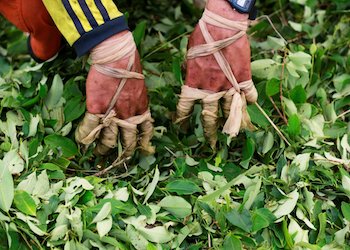New US government estimates of coca production in Colombia indicate the South American country is growing more of the drug-producing crop than ever before, a development that is likely driving changes in underworld dynamics across the Americas and the globe.
The estimates released March 14, by the White House Office of National Drug Control Policy (ONDCP) show that Colombia produced 188,000 hectares of coca crops in 2016 — a figure nearly 20 percent higher than the 2015 estimate, and nearly 80 percent higher than the average annual estimate from 2008 to 2015.
No government or non-governmental organization has estimated such high levels of coca production in Colombia since records began being kept on this issue.
InSight Crime field research supports the conclusion that Colombia is growing more coca than ever. And this in turn means that Colombian production of cocaine is also almost certainly at record levels.
Cocaine yield per hectare of coca has tripled over the past decade in some areas as farmers have begun experimenting with different strains of the plant to optimize production, and improving extraction techniques to get more cocaine out of each coca leaf.
Using InSight Crime’s conservative estimate that seven kilograms of cocaine can be produced from one hectare of coca, it is possible that as much as 1,316 metric tons of cocaine could be produced from the amount of coca cultivated in 2016.
Nearly all of the world’s cocaine is produced from coca plants grown in Colombia as well as its neighbors, Peru and Bolivia. However, coca production in the latter two countries is far less than in Colombia.
Peru produced an estimated 53,000 hectares of the crop in 2015, while Bolivia produced an estimated 36,500 hectares. Data from 2016 was not immediately available from the ONDCP.
The increase in coca cultivation in Colombia has been linked to several factors, including the end of a long-running aerial fumigation program in 2015, and ongoing economic challenges faced by many of Colombia’s rural poor.
A municipal official in the town of Roberto Payán, in Nariño department — one of the country’s main coca-growing areas — told InSight Crime, “The entire economy here is based on coca. Even though I don’t want to grow it, I’ve been forced to.”
“There’s nothing else besides coca,” said a farmer in the same town, referring to alternative sources of income. “There have been some projects, but almost all of them have failed. People always go back to growing.”
InSight Crime Analysis
Authorities and experts have been warning for months about a boom in Colombia’s coca cultivation, so the new figures from the US government come as little surprise. They do, however, serve as a reminder that record levels of Colombian cocaine production are already having an effect on the global market dynamics of one of the world’s most popular, criminally lucrative drugs.
For example, the United States, which is the world’s largest market for cocaine, recently reported the first increase in cocaine availability and abuse in years — a development that the Drug Enforcement Administration (DEA) linked to increasing production in Colombia.
Similarly, a series of recent cocaine seizures and related arrests in Spain suggests that Europe, the world’s second-largest market for the drug, may also be experiencing the effects of booming production in Colombia.
And within Latin America, cocaine use is on the rise, a phenomenon that has also been linked to increases in Colombian production of the drug.
SEE ALSO: Coverage of Coca Production
Although it is difficult to determine the accuracy of the new US government figures, there is a broad consensus that Colombia is producing more coca — and more cocaine — than ever before. And as the “lifeblood” of organized crime in Latin America, this development is likely to have profound impacts on criminal dynamics around the world.
Not only will the flourishing cocaine trade fuel the activities of crime groups in Colombia, including defectors from the demobilizing Revolutionary Armed Forces of Colombia (Fuerzas Armadas Revolucionarias de Colombia – FARC), it could also bring increasing revenues to Central American and Mexican criminal organizations with significant roles in transporting the drug from South America to the United States.
Colombia’s cocaine boom could also help strengthen crime groups in Brazil, which is the principal departure point for cocaine heading to Europe, Africa and Asia.

